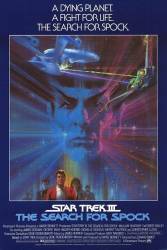Factual error: According to "The Doomsday Machine", full impulse drive is one-quarter the speed of light. In the first two movies, Enterprise used thrusters as opposed to impulse drive to leave Spacedock, confirming the notion that impulse drive is far too fast to leave such a (comparatively) small structure. Styles, however, orders Excelsior to one-quarter impulse, which is 18,750 km/s. In one second, she will travel half again Earth's diameter. From the time he gives the order to the time we see Excelsior clear spacedock's doors is approximately 40 seconds. Even allowing 30 seconds to go from rest to one quarter impulse, spacedock must be 13-15 times bigger than Earth! That's some serious engineering. (00:23:45)
Suggested correction: I reckon the writers always refer to levels of "impulse power" precisely so they don't have to worry too much about particular speeds (personally I always thought of it as roughly analogous to gears on a vehicle, but your mileage may vary). They use impulse to leave dock in both Star Trek II: The Wrath of Khan and Star Trek VI: The Undiscovered Country (it's implied to be unusual in both cases, for what it's worth). If all of that contradicts an earlier episode, I think we're looking at more of a retcon situation than a mistake.
Suggested correction: The warp scale has been adjusted several times, so it is impossible to say precisely how fast this fictional technology is, and by extension, how fast impulse is.
Impulse drive speed on starships have been consistent. Although sometimes quarter impulse on a shuttle refers to quarter power and not speed. Even if the speed of quarter impulse is 10 times slower than suggested (and used in the series), spacedock would still be 1.3-1.5 times bigger than Earth, which it wasn't. "It's fictional technology" is usually only a valid correction if the technology isn't explained in-universe. However, when certain parameters regarding fictional technology are established (even if they set wide parameters such as warp speed velocities) violations or contradictions (through bad script writing or whatnot) are valid mistakes.
Continuity mistake: When Kirk checks the video logs to find the keeper of Spock's katra, the timestamp reveals that Spock melded with McCoy on stardate 8128.78. The Wrath of Khan begins on stardate 8130.3. (00:21:50)
Suggested correction: The stardate system has never been precisely defined, so this is not a mistake.
While not precisely defined, it has been established in almost every episode that the numbers increase as time moves forward. (example in the Next Generation, the second number of the stardate corresponded with the season number, also in the episode The Best of Both Worlds, Picard gives a Stardate of 43992.6, then later 43996.2. So this mistake stands.
Revealing mistake: As the Enterprise nears the space dock doors there is an outline around the ends of the nacelles that precedes them as it moves. This shows that the ship was superimposed over the shot of the inside of the space dock.
Suggested correction: This isn't wrong, per se, but matte outlines are so inherent to this type of optical effect that it I think it would be like counting "makeup looks fake" or "unconvincing acting" as mistakes. There probably is a line where a special effect is so bad it can indeed be counted as a mistake, but this doesn't cross it, in my opinion.





